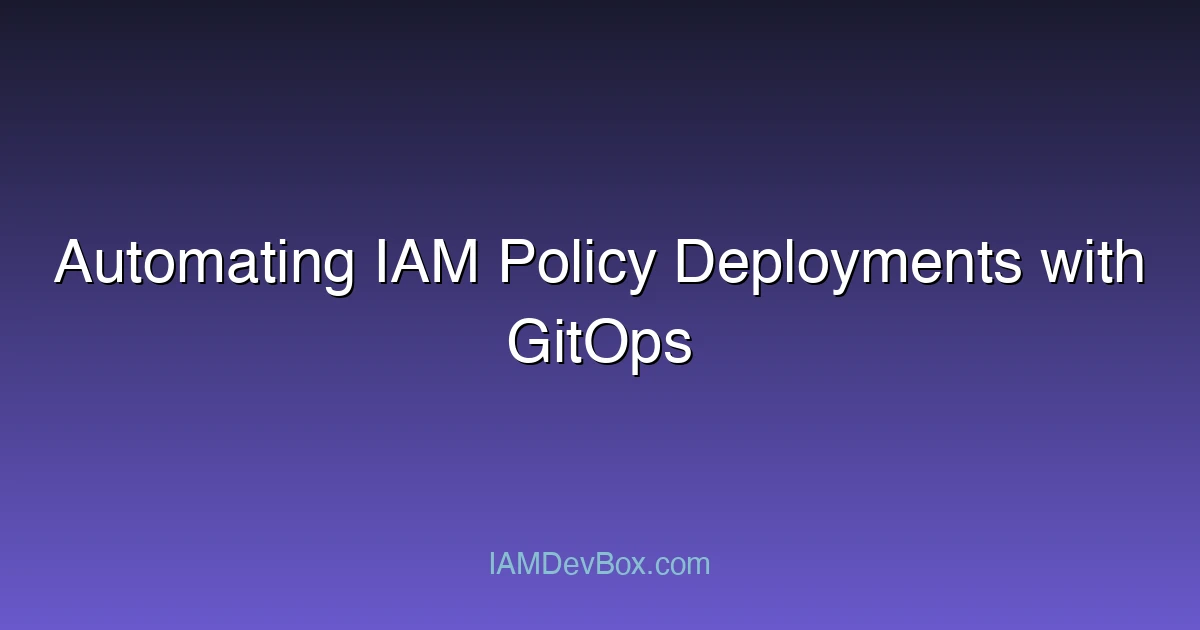Visual Overview:
graph LR
subgraph "CI/CD Pipeline"
Code[Code Commit] --> Build[Build]
Build --> Test[Test]
Test --> Security[Security Scan]
Security --> Deploy[Deploy]
Deploy --> Monitor[Monitor]
end
style Code fill:#667eea,color:#fff
style Security fill:#f44336,color:#fff
style Deploy fill:#4caf50,color:#fff
In the realm of cloud computing and DevOps, managing Identity and Access Management (IAM) policies is a critical task that often requires precision and consistency. Manual configuration of IAM policies is error-prone, time-consuming, and difficult to audit. This is where GitOps comes into play, offering a declarative approach to automate the deployment and management of IAM policies. By leveraging GitOps principles, organizations can ensure that their IAM policies are version-controlled, consistently applied, and automatically deployed across environments.
Why Automate IAM Policy Deployments?
IAM policies define who has access to what resources in your cloud environment. Misconfigurations in these policies can lead to security breaches or operational outages. Automating the deployment of IAM policies ensures consistency across environments, reduces human error, and provides a clear audit trail. With GitOps, you can version your IAM policies, track changes, and roll back to previous versions if needed.
GitOps Principles for IAM Policy Management
GitOps is more than just a buzzword; it’s a set of practices that bring the benefits of Git version control to infrastructure management. The core principles of GitOps include:
- Declarative Infrastructure: Define your IAM policies as code in a version-controlled repository.
- Version Control: Use Git to track changes to your IAM policies, ensuring a history of modifications.
- Continuous Deployment: Automatically apply changes to your IAM policies when they are merged into the main branch.
- Rollback and Auditing: Easily revert to previous versions of your policies and maintain a clear audit trail.
By applying these principles to IAM policy management, you can achieve a more robust and scalable security posture.
Implementing GitOps for IAM Policies
To implement GitOps for IAM policies, follow these steps:
- Define Policies as Code: Write your IAM policies in a structured format, such as JSON or YAML, and store them in a Git repository.
- Set Up CI/CD Pipelines: Use tools like Jenkins, GitHub Actions, or GitLab CI/CD to trigger deployments when changes are pushed to the repository.
- Integrate with Cloud Providers: Use cloud-specific tools or SDKs to apply the policies to your cloud environment.
- Monitor and Audit: Continuously monitor the state of your IAM policies and ensure they align with your defined configurations.
Example: Automating IAM Policy Deployments with AWS
Let’s walk through an example using AWS as the cloud provider. Suppose you want to automate the deployment of IAM policies for an S3 bucket.
Step 1: Define the Policy
Create a JSON file (s3_policy.json) that defines the IAM policy for your S3 bucket:
{
"Version": "2012-10-17",
"Statement": [
{
"Effect": "Allow",
"Action": [
"s3:GetObject",
"s3:PutObject"
],
"Resource": "arn:aws:s3:::my-bucket/*"
}
]
}
Step 2: Set Up the Git Repository
Initialize a Git repository and add your policy file:
git init
git add s3_policy.json
git commit -m "Initial commit of S3 IAM policy"
Step 3: Create a CI/CD Pipeline
Use GitHub Actions to create a pipeline that deploys the policy when changes are pushed to the repository. Create a workflow file (/.github/workflows/deploy.yml):
name: Deploy IAM Policy
on:
push:
branches: [ main ]
jobs:
deploy-iam-policy:
runs-on: ubuntu-latest
steps:
- name: Checkout repository
uses: actions/checkout@v2
- name: Install AWS CLI
run: |
curl "https://awscli.amazonaws.com/awscli-exe-linux-x86_64.zip" -o "awscliv2.zip"
unzip awscliv2.zip
./aws/install
- name: Deploy IAM Policy
run: |
aws iam put-policy --policy-name s3-policy --policy-document file://s3_policy.json
Step 4: Test the Pipeline
Push the workflow file to your repository and test the pipeline by making a change to your IAM policy and pushing it to the main branch. The policy should be automatically deployed to your AWS account.
Challenges and Considerations
While implementing GitOps for IAM policies offers significant benefits, there are some challenges to consider:
-
Security: Ensure that your Git repository and CI/CD pipelines are secure. Avoid committing sensitive information directly to the repository.
-
Conflict Resolution: Handle conflicts when multiple changes are made to the same policy. Use Git’s merge capabilities to resolve conflicts.
-
Testing: Implement thorough testing to ensure that your policies work as intended before they are deployed to production.
Conclusion
GitOps provides a powerful framework for automating the deployment and management of IAM policies. By treating your IAM policies as code, you can achieve greater consistency, reduce errors, and improve auditing capabilities. With the right tools and processes in place, you can streamline your IAM policy management and enhance your overall security posture.
Extended Questions for Readers
- How can you integrate GitOps with other cloud providers, such as Azure or Google Cloud?
- What are the best practices for securing your Git repository and CI/CD pipelines?
- How can you implement rollback strategies for failed IAM policy deployments?
